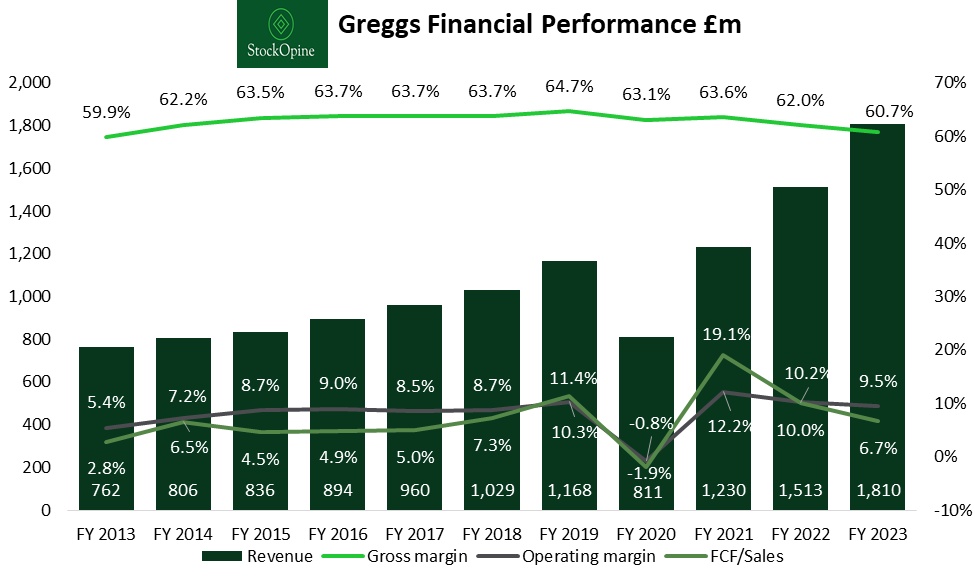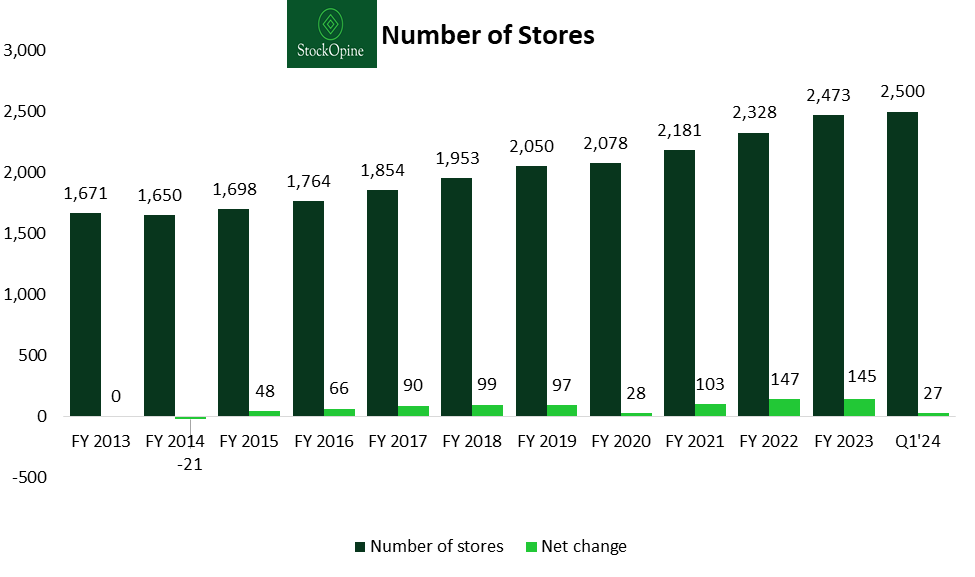We first covered Greggs plc ("Greggs", "Company") in September 2022 (article: Greggs Plc - Investment thesis), at which time execution under the leadership of its new CEO, Roisin Currie, was a key risk. Fast forward to June 2024, and Greggs has far exceeded those early expectations. In this article, we provide an update on its performance and strategic initiatives, assess future prospects and competition, and conclude with a revised valuation.
If Greggs is new to you, it trades on the London Stock Exchange under the ticker GRG and has a market cap of £2.9 billion (as of June 10, 2024). It is a modern, vertically integrated UK food-on-the-go retailer, serving consumers with 2,500 stores across the UK, of which 514 are franchised.
Over the last 10 years, Greggs has achieved a Revenue and Operating Income Compound Annual Growth Rate (“CAGR”) of 9% and 15.3%, respectively, reaching sales of £1.8 billion for its fiscal year 2023 and operating income of £171.7 million (with a margin of 9.5%). Additionally, over the past decade, it delivered a total shareholder return of 615.4% (CAGR of 21.7%).
Source: Koyfin (affiliate link with a 20% discount; if you are a paid subscriber, you can benefit from a 3-month free trial)
🎁 Premium members can benefit from a 3-MONTH FREE TRIAL on the Koyfin platform. This translates to a value of $147, covering your subscription to StockOpine. To take advantage of this opportunity, please contact us at info@stockopine.com. 🎁
Let’s dive deeper to analyze the numbers and the growth trajectory ahead!
Contents:
Performance Update (Stores, Strategic Initiatives, Profitability, CAPEX plans)
Industry (Market size, market share evolution and forecasts)
Valuation (DCF along with a sensitivity analysis)
Conclusion (final thoughts and portfolio changes)
1. Performance Update
a. Overall
Roisin Currie was appointed CEO in May 2022. Since then, Greggs' sales have grown significantly from FY21 revenues of £1.23 billion to £1.8 billion (or 47%), moving closer to the FY26 target of £2.4 billion set in October 2021. Additionally, the Company met its target of opening approximately 150 net new stores per annum, with 147 net new stores in FY22 and 145 in FY23.
While inflation has driven sales up, along with expansion in Delivery and Evening Trade (which will be examined later), rising food costs, energy prices, salary increases, and increased delivery penetration have negatively impacted profitability. This is evidenced by declining gross margins (from 63.6% in FY21 to 60.7% in FY23) and operating margins (from 12.2% in FY21 to 9.5% in FY23). With cost inflation subsiding to 4%-5%, we expect that margins could improve from here.
b. Stores
Recently, Greggs has opened its 2,500th store and has been steadily investing in formats where the market is underserved or which are new for Greggs.
Source: Greggs plc filings, StockOpine analysis
For instance, petrol forecourts are growing rapidly due to franchise partnership dynamics extending reach, while travel hubs like rail stations, underground stations, and airports (first London airport in 2023, Gatwick) as well as supermarket locations (4 new 'Tasty' cafes inside Primark stores, 17 additional shops in Tesco, and 5 new shops with Sainsbury’s in FY23) are showing favorable dynamics.
“And very pleasingly, it shows the opportunity to continue to take in roadside, in travel locations and in retail parks and supermarkets, which are new markets to us.” Roisin Currie CEO



